Partial Melting and Crustal Deformation during the Early Paleozoic Wuyi–Yunkai Orogeny: Insights from Zircon U-Pb Geochronology and Structural Analysis of the Fuhuling Migmatites in the Yunkai Region, South China
Abstract
1. Introduction
2. Geological Setting
2.1. Regional Geology
2.2. Outcrop-Scale Structure
2.3. Petrology and Microstructure
3. Sample Selection and Analytical Methods
4. Results
4.1. Zircon U-Pb Geochronology
4.1.1. Metatexite
4.1.2. Diatexite
4.1.3. Biotite Monzogranite
4.1.4. Summary of U-Pb Zircon Ages from Migmatites
4.2. Zircon Trace Elements
4.2.1. Metatexite
4.2.2. Diatexite
4.2.3. Biotite Monzogranite
5. Discussion
5.1. Significance of Zircon U-Pb Ages and Trace Element Compositions
5.1.1. Nature of the Protoliths
5.1.2. Timing of Crustal Partial Melting in Yunkai Region
5.2. Migmatite Morphology and Development
5.3. Mechanisms and Causes of Partial Melting at Fuhuling
5.4. Rheology of the Yunkai Region during the Wuyi–Yunkai Orogeny
6. Conclusions
Supplementary Materials
Author Contributions
Funding
Acknowledgments
Conflicts of Interest
References
- Brown, M. The generation, segregation, ascent and emplacement of granite magma: The migmatite-to-crusstally-derived granite connection in thickened orogens. Earth Sci. Rev. 1994, 36, 83–130. [Google Scholar] [CrossRef]
- Nelson, K.D.; Zhao, W.; Brown, L.D.; Kuo, J.; Che, J.; Liu, X.W.; Klemperer, S.L.; Makovsky, Y.; Meissner, R.; Mechie, J.; et al. Partially molten middle crust beneath Southern Tibet: Synthesis of project INDEPTH results. Science 1996, 274, 1684–1688. [Google Scholar] [CrossRef] [PubMed]
- Vanderhaeghe, O.; Teyssier, C. Partial melting and flow of orogens. Tectonophysics 2001, 342, 451–472. [Google Scholar] [CrossRef]
- Groome, W.G.; Koons, P.O.; Johnson, S.E. Metamorphism, transient mid-crustal rheology, strain localization and the exhumation of high-grade metamorphic rocks. Tectonics 2008, 27. [Google Scholar] [CrossRef]
- Sawyer, E.W.; Cesare, B.; Brown, M. When the continental crust melts. Elements 2011, 7, 229–234. [Google Scholar] [CrossRef]
- Hollister, L.S. The role of melt in the uplift and exhumation of orogenic belts. Chem. Geol. 1993, 108, 31–48. [Google Scholar] [CrossRef]
- Brown, M. Crustal melting and melt extraction, ascent and emplacement inorogens: Mechanisms and consequences. J. Geol. Soc. 2007, 164, 709–730. [Google Scholar] [CrossRef]
- Sawyer, E.W. Melt segregation in the continental crust. Geology 1994, 22, 1019–1022. [Google Scholar] [CrossRef]
- Wickham, S.M. The segregation and emplacement of granitic magmas. J. Geol. Soc. 1987, 144, 281–297. [Google Scholar] [CrossRef]
- Vanderhaeghe, O. Melt segragation, pervasive melt migration and magma mobility in the continental crust: The structural record from pores to orogens. Phys. Chem. Earth Part A Solid Earth Geod. 2001, 26, 213–223. [Google Scholar] [CrossRef]
- Vanderhaeghe, O. Migmatites, granites and orogeny: Flow modes of partially-molten rocks and magmas associated with melt/solid segregation in orogenic belts. Tectonophysics 2009, 477, 119–134. [Google Scholar] [CrossRef]
- Mclellan, E.L. Deformational behaviour of migmatites and problems of structural analysis in migmatite terrains. Geol. Mag. 1984, 121, 339–345. [Google Scholar] [CrossRef]
- Brown, M.; Averkin, Y.A.; McLellan, E.L.; Sawyer, E.W. Melt segregation in migmatites. J. Geophys. Res. 1995, 100, 15655–15679. [Google Scholar] [CrossRef]
- Brown, M. The definition of metatexis, diatexis and migmatite. Proc. Geologists’ Assoc. 1973, 84, 371–382. [Google Scholar] [CrossRef]
- Sawyer, E.W. Formation and evolution of granite magmas during crustal reworking: The significance of diatexites. J. Petrol. 1998, 39, 1147–1167. [Google Scholar] [CrossRef]
- White, R.W.; Pomroy, N.E.; Powell, R. An in situ metatexite-diatexite transition in upper amphibolite facies rocks from Broken Hill, Australia. J. Metamorph. Geol. 2005, 23, 579–602. [Google Scholar] [CrossRef]
- Holness, M.B. Working with migmatites: Decoding migmatite microstructures. In Working with Migmatites; Sawyer, E.W., Brown, M., Eds.; Short Course Series; Mineralogical Association of Canada: Quebec, QC, Canada, 2008; Volume 38, pp. 57–76. [Google Scholar]
- Kruckenberg, S.C.; Vanderhaeghe, O.; Ferré, E.C.; Teyssier, C.; Whitney, D.L. Flow of partially molten crust and the internal dynamics of a migmatite dome, Naxos, Greece. Tectonics 2011, 30, 445–455. [Google Scholar] [CrossRef]
- Weinberg, R.F.; Mark, G. Magma migration, folding, and disaggregation of migmatites in the Karakoram shear zone, Ladakh, NW India. Geol. Soc. Am. Bull. 2008, 120, 994–1009. [Google Scholar] [CrossRef]
- Viegas, L.G.F.; Archanjo, C.J.; Vauchez, A. Fabrics of migmatites and the relationships between partial melting and deformation in high-grade transpressional shear zones: The Espinho Branco anatexite (BorboremaProvince, NE Brazil). J. Struct. Geol. 2013, 48, 45–56. [Google Scholar] [CrossRef]
- Stipska, P.; Schulmann, K.; Powell, R. Contrasting metamorphic histories of lenses of high-pressure rocks and host migmatites with a flat orogenic fabric (Bohemian Massif, Czech Republic): A result of tectonic mixing within horizontal crustal flow? J. Metamorph. Geol. 2008, 26, 623–646. [Google Scholar]
- Vernon, R.H. Review of microstructural evidence of magmatic and solid-state flow. Vis. Geosci. 2000, 5, 1–23. [Google Scholar] [CrossRef]
- Rosenberg, C.L. Deformation of partially molten granite: A review and comparison of experimental and natural case studies. Int. J. Earth Sci. 2001, 90, 60–76. [Google Scholar] [CrossRef]
- Saki, A. Migmatite microstructures and partial melting of Hamadan metapelitic rocks, Alvand contact aureole, western Iran. Int. Geol. Rev. 2012, 54, 1229–1240. [Google Scholar] [CrossRef]
- Sawyer, E.W. Working with migmatites: Nomenclature for the constituent parts. In Working with Migmatites; Sawyer, E.W., Brown, M., Eds.; Short Course Series; Mineralogical Association of Canada: Quebec, QC, Canada, 2008; Volume 38, pp. 1–28. [Google Scholar]
- Yakymchuk, C.; Brown, M.; Ivanic, T.J.; Korhonen, F.J. Leucosome distribution in migmatitic paragneisses and orthogneisses: A record of self-organized melt migration and entrapment in a heterogeneous partially-molten crust. Tectonophysics 2013, 603, 136–154. [Google Scholar] [CrossRef]
- Brown, M. Introduction to a virtual special issue on crustal melting. J. Metamorph. Geol. 2012, 30, 453–456. [Google Scholar] [CrossRef]
- Searle, M. Crustal melting, ductile flow, and deformation in mountain belts: Cause and effect relationships. Lithosphere 2013, 5, 547–554. [Google Scholar] [CrossRef]
- Li, Z.X.; Li, X.H.; Wartho, J.A.; Clark, C.; Li, W.X.; Zhang, C.L.; Bao, C.M. Magmatic and metamorphic events during the Early Paleozoic Wuyi–Yunkai Orogeny, southeastern South China: New age constraints and P–T conditions. GSA Bull. 2010, 122, 772–793. [Google Scholar] [CrossRef]
- Wang, Y.J.; Zhang, A.M.; Fan, W.M.; Zhao, G.C.; Zhang, G.W.; Zhang, Y.Z.; Zhang, F.F.; Li, S.H. Kwangsian crustal anatexis within theeastern South China Block: Geochemical, zircon U-Pb geochronological and Hf isotopic finger prints from the gneissoid granites of Wugong and Wuyi-Yunkai Domains. Lithos 2011, 127, 239–260. [Google Scholar] [CrossRef]
- Wang, D.; Zheng, J.; Ma, Q.; Griffin, W.L.; Zhao, H.; Wong, J. Early Paleozoic crustal anatexis in the intraplate Wuyi-Yunkai orogen, South China. Lithos 2013, 175, 124–145. [Google Scholar] [CrossRef]
- Liu, R.; Zhou, H.; Zhang, L.; Zhong, Z.Q.; Zeng, W.; Xiang, H.; Jin, S.; Lu, X.Q.; Li, C.Z. Zircon U-Pb ages and Hf isotope compositions of the Mayuan migmatite complex, NWFujian province, Southeast China: Constraints on the timing and nature of a regional tectonothermal event associated with the Caledonian orogeny. Lithos 2010, 119, 163–180. [Google Scholar] [CrossRef]
- Peng, S.P.; Peng, S.M.; Shao, J.G. Microscopic-ultra microscopic analysis of different deformational phases in Yunkai area and its significance. Guangdong Geol. 1995, 10, 17–24, (In Chinese with English abstract). [Google Scholar]
- Wang, Y.X.; Zhao, Z.H.; Bao, Z.W.; Li, X.H. Geochemistry of granitoids from Zhejiang Province and crustal evolution-II. Proterozoic granitoids. Geochimica 1997, 26, 57–68, (In Chinese with English abstract). [Google Scholar]
- Shen, W.Z.; Ling, H.F.; Li, W.X.; Huang, X.L.; Wang, D.Z. Study on the Nd-Sr isotopic compositions of granitoids in SE China. Geol. J. China Univ. 1999, 5, 22–32, (In Chinese with English abstract). [Google Scholar]
- Zheng, Y.F.; Zhang, S.B. Formation and evolution of Precambrian continental crust in South China. Chin. Sci. Bull. 2007, 52, 1–12. [Google Scholar] [CrossRef]
- Wan, Y.S.; Liu, D.Y.; Wilde, S.A.; Cao, J.J.; Chen, B.; Dong, C.Y.; Song, B.; Du, L.L. Evolution of the Yunkai terrane, South China: Evidence from SHRIMP zircon U-Pb dating, geochemistry and Nd isotope. J. Asian Earth Sci. 2010, 37, 140–153. [Google Scholar] [CrossRef]
- Zhang, J.H.; Chen, Z.; Chen, G.N.; Ding, R.X.; Peng, Z.L. Studies of formation temperature of Caledonian migmatite-granite at the Fuhuling area of the southern Qinzhou-Hangzhou zone, South China. Acta Petrol. Sin. 2017, 33, 887–895, (In Chinese with English abstract). [Google Scholar]
- Charvet, J.; Shu, L.S.; Shi, Y.S.; Guo, L.Z.; Faure, M. The building of South China: Collision of Yangzi and Cathaysia Blocks, problems and tentative answers. J. Southeast Asian Earth Sci. 1996, 13, 223–235. [Google Scholar] [CrossRef]
- Wang, Y.J.; Fan, W.; Zhang, G.; Zhang, Y. Phanerozoic tectonics of the south china block: Key observations and controversies. Gondwana Res. 2013, 23, 1273–1305. [Google Scholar] [CrossRef]
- Lin, W.; Wang, Q.C.; Chen, K. Phanerozoic tectonics of South China Block: New insights from the polyphase deformation in the Yunkai massif. Tectonics 2008, 27. [Google Scholar] [CrossRef]
- Ke, X.Z.; Zhou, D.; Long, W.G.; Wang, J.; Xu, D.M.; Tian, Y.; Jin, W. Indosinian metamorphism and anatexis in Yunkai Massif: Evidences from zircon geochronology and Hf isotopes of migmatites and gneisses. Earth Sci. 2018, 8. (In Chinese with English abstract). [Google Scholar] [CrossRef]
- Zhou, X.Y.; Yu, J.H.; Wang, L.J.; Shen, L.W.; Zhang, C.H. Compositions andformation of the basement metamorphicrocks in Yunkai terrane, western Guangdong Province, South China. Acta Petrol. Sin. 2015, 31, 855–882, (In Chinese with English abstract). [Google Scholar]
- RGMRGD. Regional Geological Mapping and Report of Guangdong Province-Yangjiang Sheet; Scale 1:200,000; Institute of Geoscience, Ministry of Geology: Beijing, China, 1964. (In Chinese) [Google Scholar]
- Bureau of Geology and Mineral Resources of Guangdong Province (BGMRGD). Regional Geology of the Guangdong Province; Geological Publishing House: Beijing, China, 1988; (In Chinese with English abstract). [Google Scholar]
- Wu, Y.B.; Zheng, Y.F.; Zhang, S.B.; Zhao, Z.F.; Wu, F.Y.; Liu, X.M. Zircon U–Pb ages and Hf isotope compositions of migmatite from the North Dabie terrane in China: Constraints on partial melting. J. Metamorph. Geol. 2010, 25, 991–1009. [Google Scholar] [CrossRef]
- Yao, J.; Shu, L.S.; Cawood, P.A.; Li, J.Y. Constraining timing and tectonic implications of Neoproterozoic metamorphic event in the Cathaysia block, South China. Precambrian Res. 2017, 293, 1–12. [Google Scholar] [CrossRef]
- Morfin, S.; Sawyer, E.W.; Bandyayera, D. Largevolumes of anatectic melt retained in granulite facies migmatites: An injection complex in northern Quebec. Lithos 2013, 168–169, 200–218. [Google Scholar] [CrossRef]
- Holness, M.B.; Clemens, J.D. Partial melting of the Appin quartzite driven by fracture controlled H2O infiltration in the aureole of the Ballachulish Igneous Complex, Scottish Highlands. Contrib. Mineral. Petrol. 1999, 136, 154–168. [Google Scholar] [CrossRef]
- Liu, R.; Zhang, L.; Zhou, H.W.; Zhong, Z.Q.; Zeng, W.; Xiang, H.; Jin, S.; Lu, X.Q.; Li, C.Z. Petrogenesis of the Caledonian migmatitesa and related granites in northwestern Fujian province, South China: Syn-deformation crustal anatexis. Acta Petrol. Sin. 2008, 24, 1205–1222. [Google Scholar]
- Liu, Y.S.; Gao, S.; Hu, Z.C.; Gao, C.G.; Zong, K.Q.; Wang, D.B. Continental and oceanic crust recycling-induced melt-peridotite interactions in the Trans-North China orogen: U-Pb dating, Hf isotopes and trace elements in zircons from mantle xenoliths. J. Petrol. 2010, 51, 537–571. [Google Scholar] [CrossRef]
- Andersen, T. Correction of common lead in U-Pb analyses that do not report 204Pb. Chem. Geol. 2002, 192, 59–79. [Google Scholar] [CrossRef]
- Ludwig, K.R. ISOPLOT 3.00, A Geochronology Toolkit for Microsoft Excel; Berkeley Geochronological Center Special Publication: Berkeley, CA, USA, 2003. [Google Scholar]
- Hoskin, P.W.O.; Black, L. Metamorphic zircon formation by solid-state recrystallization of protolith igneous zircon. J. Metamorph. Geol. 2000, 18, 423–439. [Google Scholar] [CrossRef]
- Corfu, F.; Hanchar, J.M.; Hoskin, P.W.O.; Kinny, P.D. Atlas of zircon textures. Rev. Mineral. Geochem. 2003, 53, 469–500. [Google Scholar] [CrossRef]
- Hoskin, P.W.O.; Schaltegger, U. The Composition of zircon and igneous and metamorphic petrogenesis. Rev. Mineral. Geochem. 2003, 53, 27–62. [Google Scholar] [CrossRef]
- Hoskin, P.W.O.; Ireland, T.R. Rare earth element chemistry of zircon and its use as a provenance indicator. Geology 2000, 28, 627. [Google Scholar] [CrossRef]
- Mcdonough, W.F.; Sun, S.S. The composition of the earth. Chem. Geol. 1995, 120, 223–253. [Google Scholar] [CrossRef]
- Watson, E.B.; Harrison, T.M. Zircon saturation revisited: Temperature and composition effects in a variety of crustal magma types. Earth Planet. Sci. Lett. 1983, 64, 295–304. [Google Scholar] [CrossRef]
- Paterson, B.A.; Stephens, W.E.; Rogers, G.; Williams, I.S.; Hinton, R.W.; Herd, D.A. The nature of zircon inheritance in two granite plutons. Trans. R. Soc. Edinb. Earth Sci. 1992, 83, 459–471. [Google Scholar]
- Clemens, J.D. S-type granitic magmas-petrogenetic issues, models and evidence. Earth Sci. Rev. 2003, 61, 1–18. [Google Scholar] [CrossRef]
- Zeck, H.P.; Williams, I.S. Inherited and magmatic zircon from Neogene Hoyazo cordierite dacite, SE Spain-anatectic source rock provenance and magmatic evolution. J. Petrol. 2002, 43, 1089–1104. [Google Scholar] [CrossRef]
- Whitehouse, M.J.; Platt, J. Dating high-grade metamorphism-constraints from rare-earth elements in zircon and garnet. Contrib. Mineral. Petrol. 2003, 145, 61–74. [Google Scholar] [CrossRef]
- Yu, J.H.; O’Reilly, S.Y.; Wang, L.; Griffin, W.L.; Zhou, M.F.; Zhang, M.; Shu, L. Components and episodic growth of Precambrian crust in the Cathaysia Block, South China: Evidence from U–Pb ages and Hf isotopes of zircons in Neoproterozoic sediments. Precambrian Res. 2010, 181, 97–114. [Google Scholar] [CrossRef]
- Wang, L.; Long, W.G.; Xu, D.M.; Xu, W.C.; Zhou, D.; Jin, X.B.; Huang, H.; Zhang, K. Zircon U-Pb geochronology of metamorphic basement in Yunkai area and its implications on the Grenvillian event in the Cathaysia Block. Earth Sci. Front. 2015, 22, 25–40, (In Chinese with English abstract). [Google Scholar]
- Johannes, W. Migmatites: The significance of experimental studies for the formation of migmatites. In Migmatites; Ashworth, J.R., Ed.; Springer: Boston, MA, USA, 1985; pp. 36–85. [Google Scholar]
- Schaltegger, U.; Fanning, C.M.; Günther, D.; Maurin, J.C.; Schulmann, K.; Gebauer, D. Growth, annealing and recrystallization of zircon and preservation of monazite in high-grade metamorphism: Conventional and in-situ U-Pb isotope, Cathodoluminescence and microchemical evidence. Contrib. Mineral. Petrol. 1999, 134, 186–201. [Google Scholar] [CrossRef]
- Harley, S.L.; Kelly, N.M.; Moller, A. Zircon Behaviour and the Thermal Histories of Mountain Chains. Elements 2007, 3, 25–30. [Google Scholar] [CrossRef]
- Foster, D.A.; Schafer, C.; Fanning, C.M.; Hyndman, D.W. Relationships between crustal partial melting, plutonism, orogeny, and exhumation: Idaho-Bitterroot batholith. Tectonophysics 2001, 342, 313–350. [Google Scholar] [CrossRef]
- Rubatto, D. Zircon trace element geochemistry: Partitioning with garnet and the link between U-Pb ages and metamorphism. Chem. Geol. 2002, 184, 123–138. [Google Scholar] [CrossRef]
- Kelsey, D.E.; Clark, C.; Hand, M. Thermobarometric modelling of zircon and monazite growth in melt-bearing systems: Examples using model metapelitic and metapsammitic granulites. J. Metamorph. Geol. 2008, 26, 199–212. [Google Scholar] [CrossRef]
- Yakymchuk, C.; Brown, M. Behaviour of zircon and monazite during crustal melting. J. Geol. Soc. Lond. 2014, 171, 465–479. [Google Scholar] [CrossRef]
- Kohn, M.J.; Corrie, S.L.; Markley, C. The fall and rise of metamorphic zircon. Am. Mineral. 2015, 100, 897–908. [Google Scholar] [CrossRef]
- Yakymchuk, C.; Clark, C.; White, R.W. Phase relations, reaction sequences and petrochronology. Rev. Mineral. Geochem. 2017, 83, 13–53. [Google Scholar] [CrossRef]
- Yakymchuk, C.; Kirkland, C.L.; Clark, C. Th/U ratios in metamorphic zircon. J. Metamorph. Geol. 2018, 36, 715–737. [Google Scholar] [CrossRef]
- Cavalcante, G.C.G.; Viegas, G.; Archanjo, C.J.; Silva, M.E.D. The influence of partial melting and melt migration on the rheology of the continental crust. J. Geodyn. 2016, 101, 186–199. [Google Scholar] [CrossRef]
- Charvet, J. The Neoproterozoic–Early paleozoic tectonic evolution of the south china block: An overview. J. Asian Earth Sci. 2013, 74, 198–209. [Google Scholar] [CrossRef]
- Wang, Y.J.; Fan, W.M.; Zhao, G.C.; Ji, S.C.; Peng, T.P. Zircon U–Pb geochronology of gneissic rocks in the Yunkai Massif and its implications on the Caledonian event in the South China Block. Gondwana Res. 2007, 12, 404–416. [Google Scholar] [CrossRef]
- Yao, W.H.; Li, Z.X.; Li, W.X.; Li, W.X.; Wang, X.C.; Li, X.H.; Yang, J.H. Post-kinematic lithospheric delamination of the Wuyi–Yunkai orogen in South China: evidence from ca. 435 Ma high-Mg basalts. Lithos 2012, 154, 115–129. [Google Scholar] [CrossRef]
- Brown, M. Granite: From genesis to emplacement. Geol. Soc. Am. Bull. 2013, 125, 1079–1113. [Google Scholar] [CrossRef]
- Weinberg, R.F.; Hasalová, P. Water-fluxed melting of the continental crust: A review. Lithos 2015, 212–215, 158–188. [Google Scholar] [CrossRef]
- Yakymchuk, C.; Zhao, W.; Wan, Y.; Lin, S.; Longstaffe, F.J. Fluid-present anatexis of Neoarchean tonalite and amphibolite in the Western Shandong Province. Lithos 2019, 326, 110–124. [Google Scholar] [CrossRef]
- Yakymchuk, C.; Brown, M. Consequences of open-system melting in tectonics. J. Geol. Soc. 2014, 171, 21–40. [Google Scholar] [CrossRef]
- Kelsey, D.E.; Hand, M. On ultrahigh temperature crustal metamorphism: Phase equilibria, trace element thermometry, bulk composition, heat sources, timescales and tectonic settings. Geosci. Front. 2015, 6, 311–356. [Google Scholar] [CrossRef]
- Brown, M. Orogeny, migmatites and leucogranites: A review. J. Earth Planet. Sci. 2001, 110, 313–336. [Google Scholar] [CrossRef]
- Kriegsman, L.M. Partial melting, partial melt extraction and partial back reaction in anatectic migmatites. Lithos 2001, 56, 75–96. [Google Scholar] [CrossRef]
- Rosenberg, C.L.; Riller, U. Partial-melt topology in statically and dynamically recrystallized granite. Geology 2000, 28, 7–10. [Google Scholar] [CrossRef]
- Rosenberg, C.L.; Handy, M.R. Experimental deformation of partially melted granite revisited: Implications for the continental crust. J. Metamorph. Geol. 2005, 23, 19–28. [Google Scholar] [CrossRef]
- Soesoo, A.; Bons, P.D. From Migmatites to plutons: Power law relationships in the evolution of magmatic bodies. Pure Appl. Geophys. 2014, 172, 1787–1801. [Google Scholar] [CrossRef]
- Arzi, A.A. Critical phenomena in the rheology of partially melted rocks. Tectonophysics 1978, 44, 173–184. [Google Scholar] [CrossRef]
- Takeda, Y.; Obata, M. Some comments on the rheologically critical melt percentage. J. Struct. Geol. 2003, 25, 813–818. [Google Scholar] [CrossRef]
- Chen, Z.; Liu, Y.J.; Chen, G.N.; Peng, Z.L. Rheological transitions in progressive melting of rock and their geological constraints from the Fuhu metatexite-diatexite profile in Guangdong province, SE China. J. Asian Earth Sci. 2017, 139, 192–201. [Google Scholar] [CrossRef]
- Jamieson, R.A.; Unsworth, M.J.; Harris, N.B.; Rosenberg, C.L.; Schulmann, K. Crustal Melting and the Flow of Mountains. Elements 2011, 7, 253–260. [Google Scholar] [CrossRef]
- Clemens, J.D. Melting of the continental crust: Fluid regimes, melting reactions, and source-rock fertility. In Evolution and Differentiation of the Continental Crust; Brown, M., Rushmer, T., Eds.; Cambridge University Press: Cambridge, UK, 2006; pp. 297–331. [Google Scholar]
- White, R.W. Working with migmatites: Insights gained from the petrological modelling of migmatites: Particular reference to mineral assemblages and common replacement textures. In Working with Migmatites; Sawyer, E.W., Brown, M., Eds.; Short Course Series; Mineralogical Association of Canada: Quebec, QC, Canada, 2008; Volume 38, pp. 77–96. [Google Scholar]
- Diener, J.F.A.; Fagereng, Å. The influence of melting and melt drainage on crustal rheology during orogenesis. J. Geophys. Res. Solid Earth. 2015, 119, 6193–6210. [Google Scholar] [CrossRef]
- Olsen, S.N.; Marsh, B.D.; Baumgartner, L. Modelling mid-crustal migmatite terrains as feeder zones for granite plutons: The competing dynamics of melt transfer by bulk versus porous flow. Trans. R. Soc. Edinb. Earth Sci. 2004, 95, 49–58. [Google Scholar]
- Barraud, J.; Véronique, G.; Allemand, P.; Grandjean, P. Analogue models of melt-flow networks in folding migmatites. J. Struct. Geol. 2004, 26, 307–324. [Google Scholar] [CrossRef]
- Kruckenberg, S.C. The Dynamics of Migmatite Domes in Extending Orogens. Ph.D. Thesis, University of Minnesota, Minneapolis, MN, USA, 2009. [Google Scholar]
- Rey, P.; Vanderhaeghe, O.; Teyssier, C. Gravitational collapse of the continental crust; definition, regimes and modes. Tectonophysics 2001, 342, 435–449. [Google Scholar] [CrossRef]
- Whitney, D.L.; Teyssier, C.; Vanderhaeghe, O. Gneiss domes and crustal flow. In Gneiss Domes in Orogeny; Whitney, D.L., Ed.; Paper 380; Geological Society of America: Boulder, CO, USA, 2004; pp. 15–33. [Google Scholar]
- Marchildon, N.; Brown, M. Spatial distribution of melt-bearing structures in anatectic rocks from Southern Brittany, France: Implications for melt transfer at grain-to orogen-scale. Tectonophysics 2003, 364, 215–235. [Google Scholar] [CrossRef]
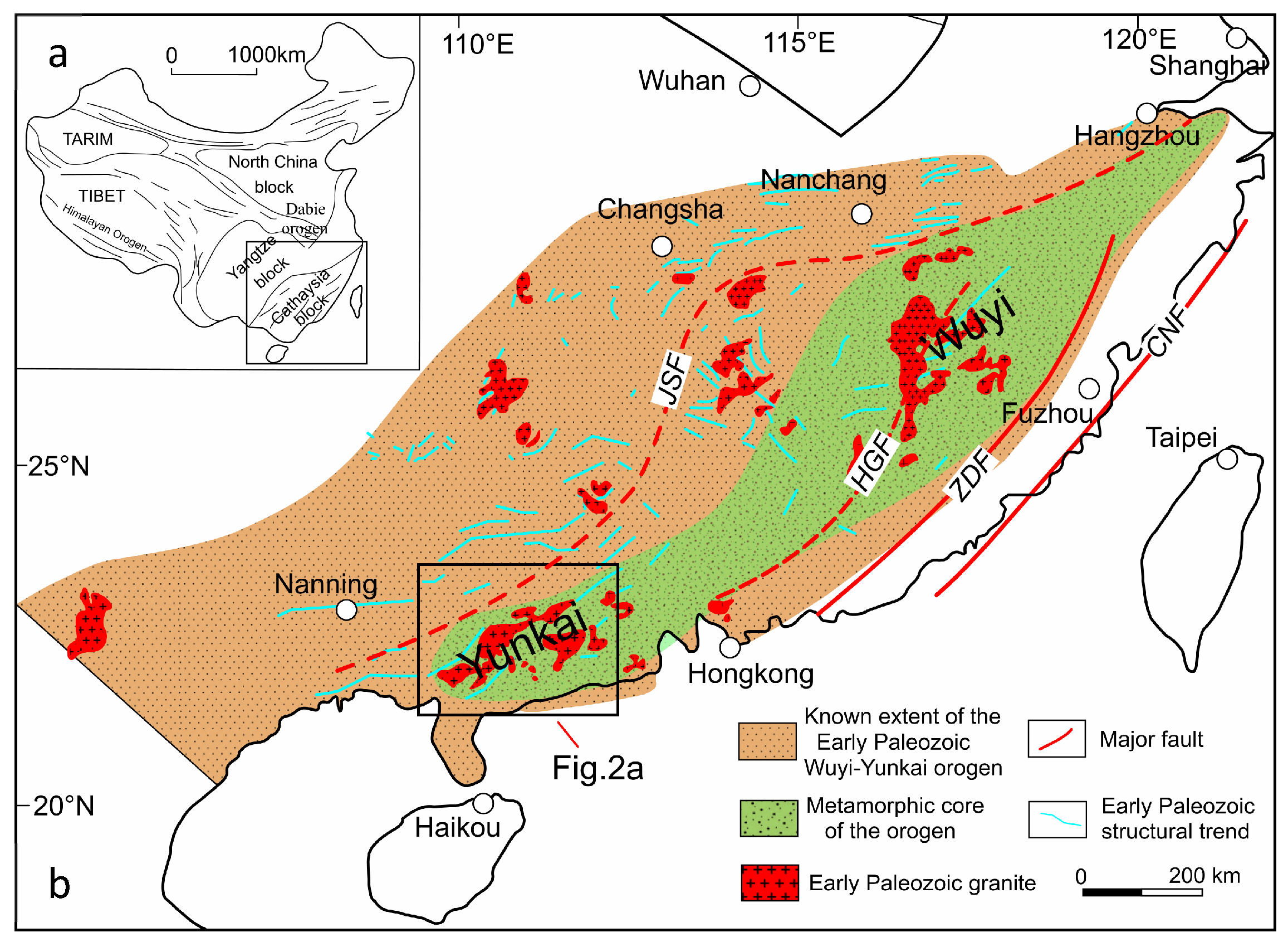
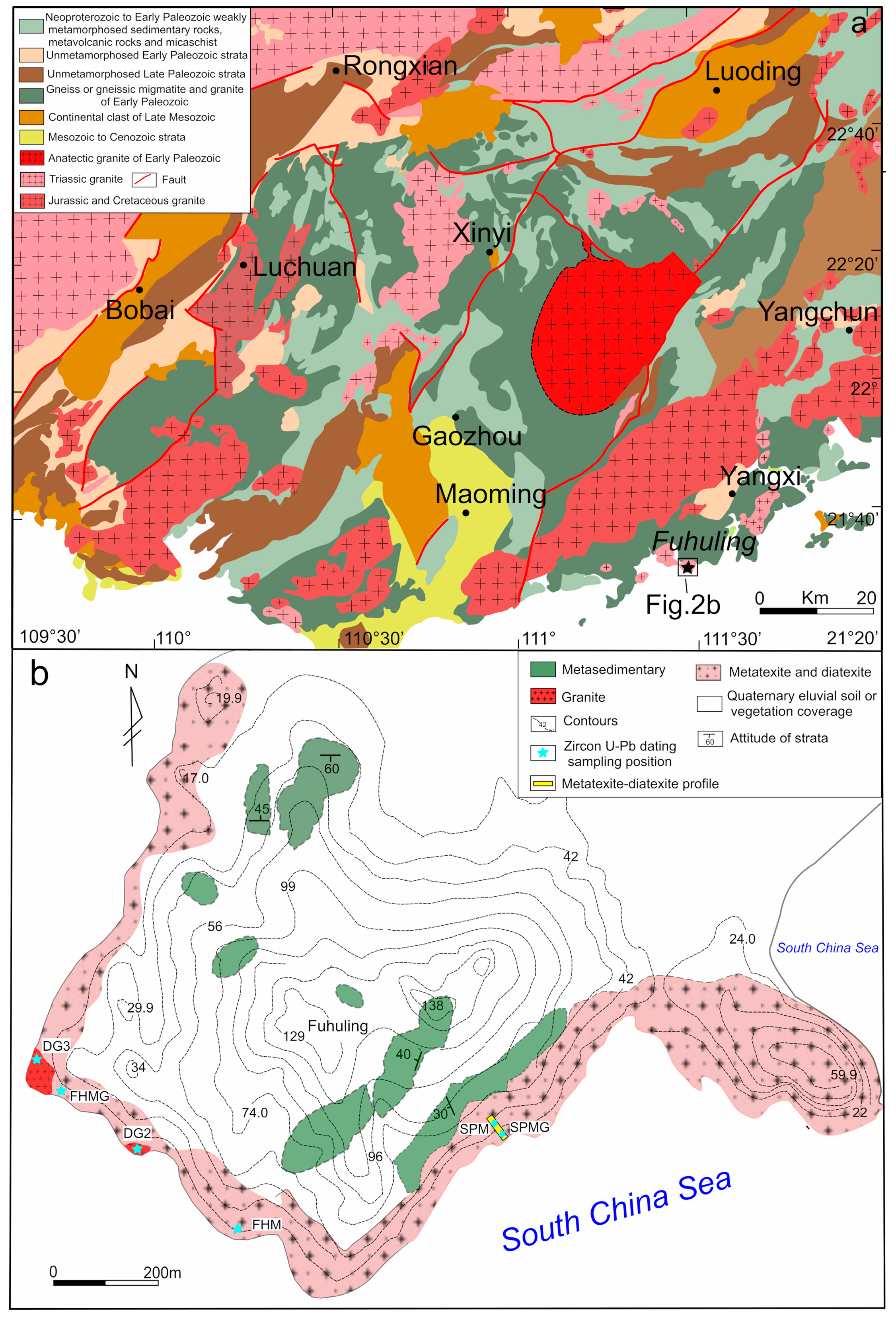
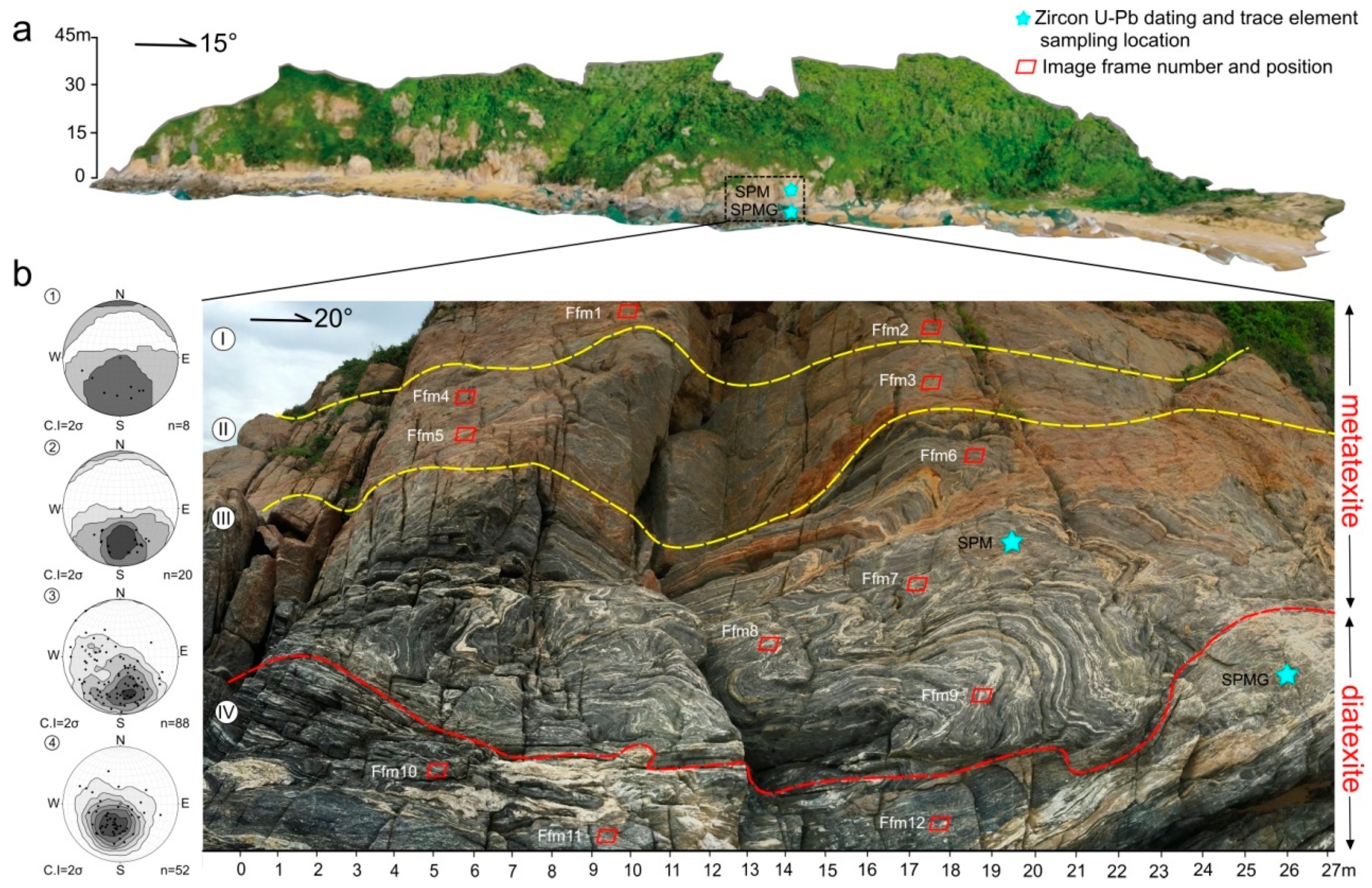
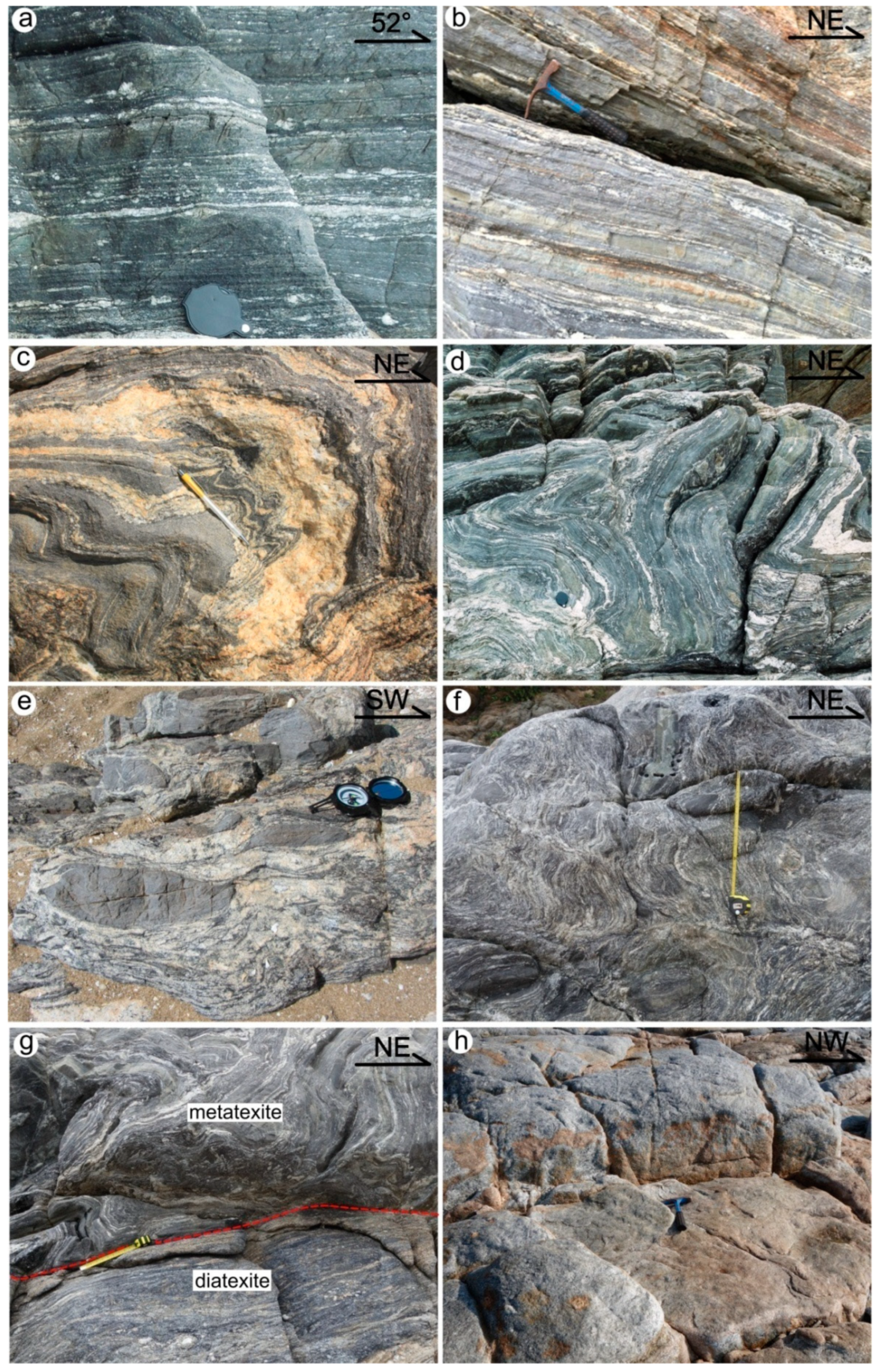
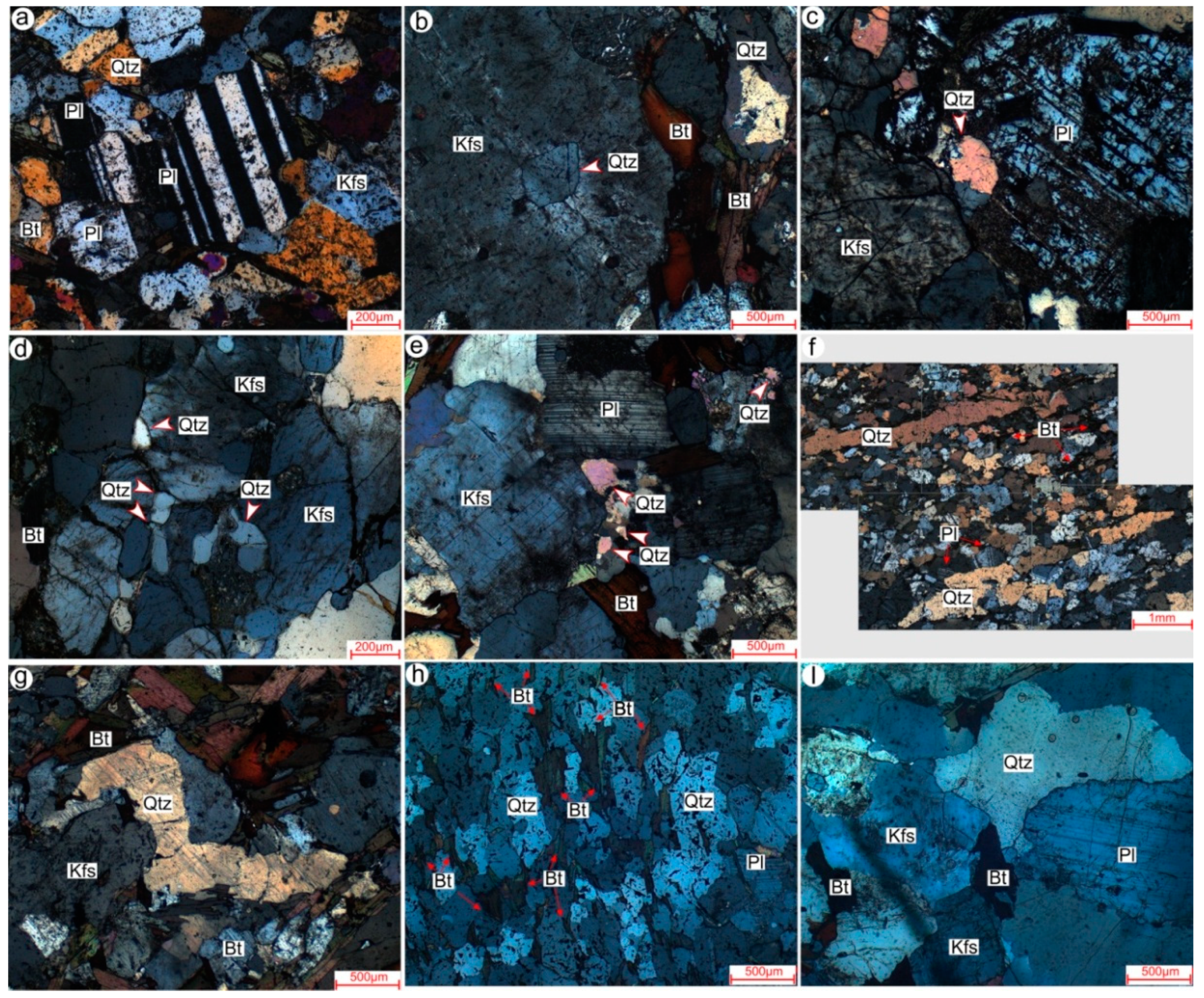
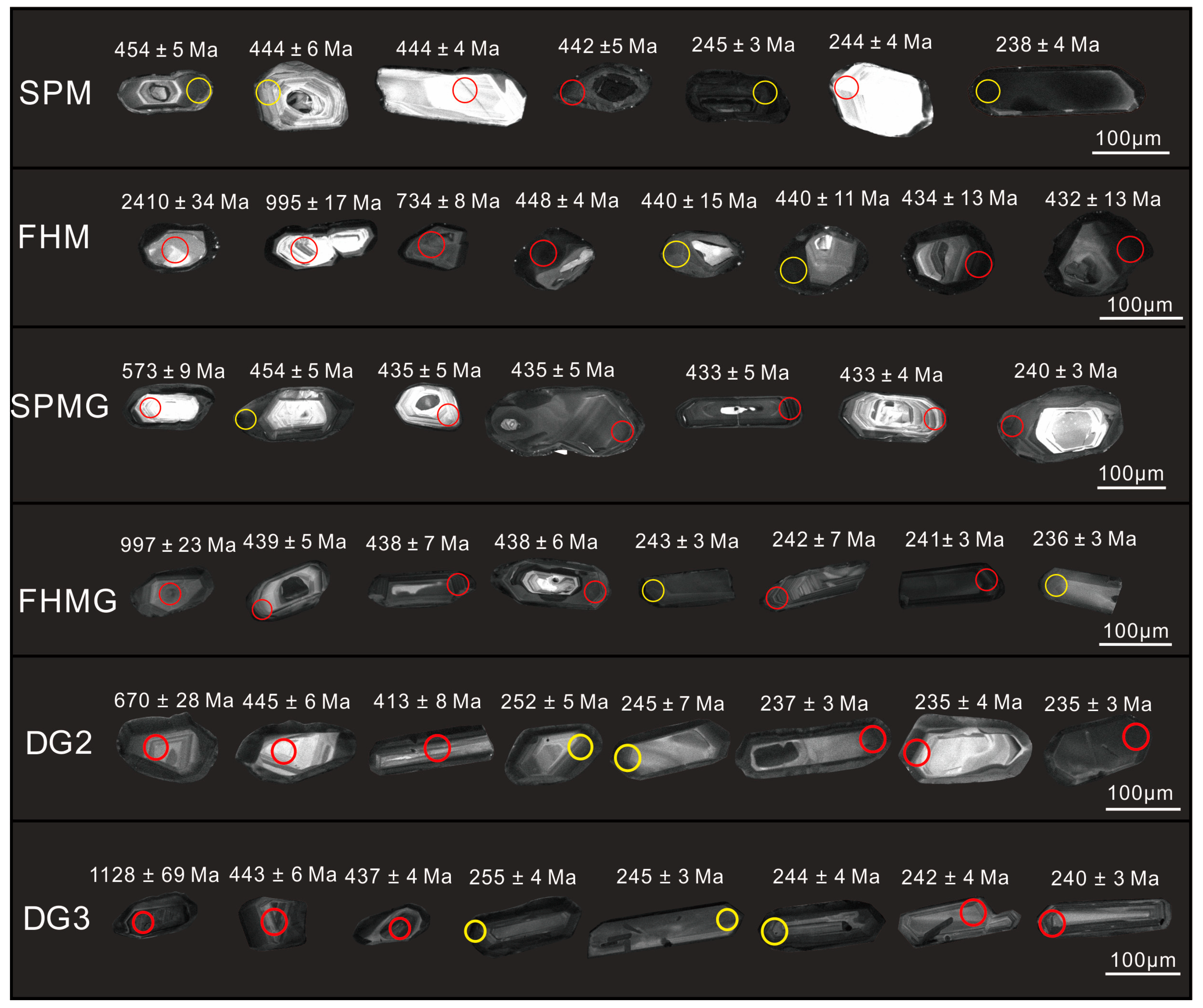

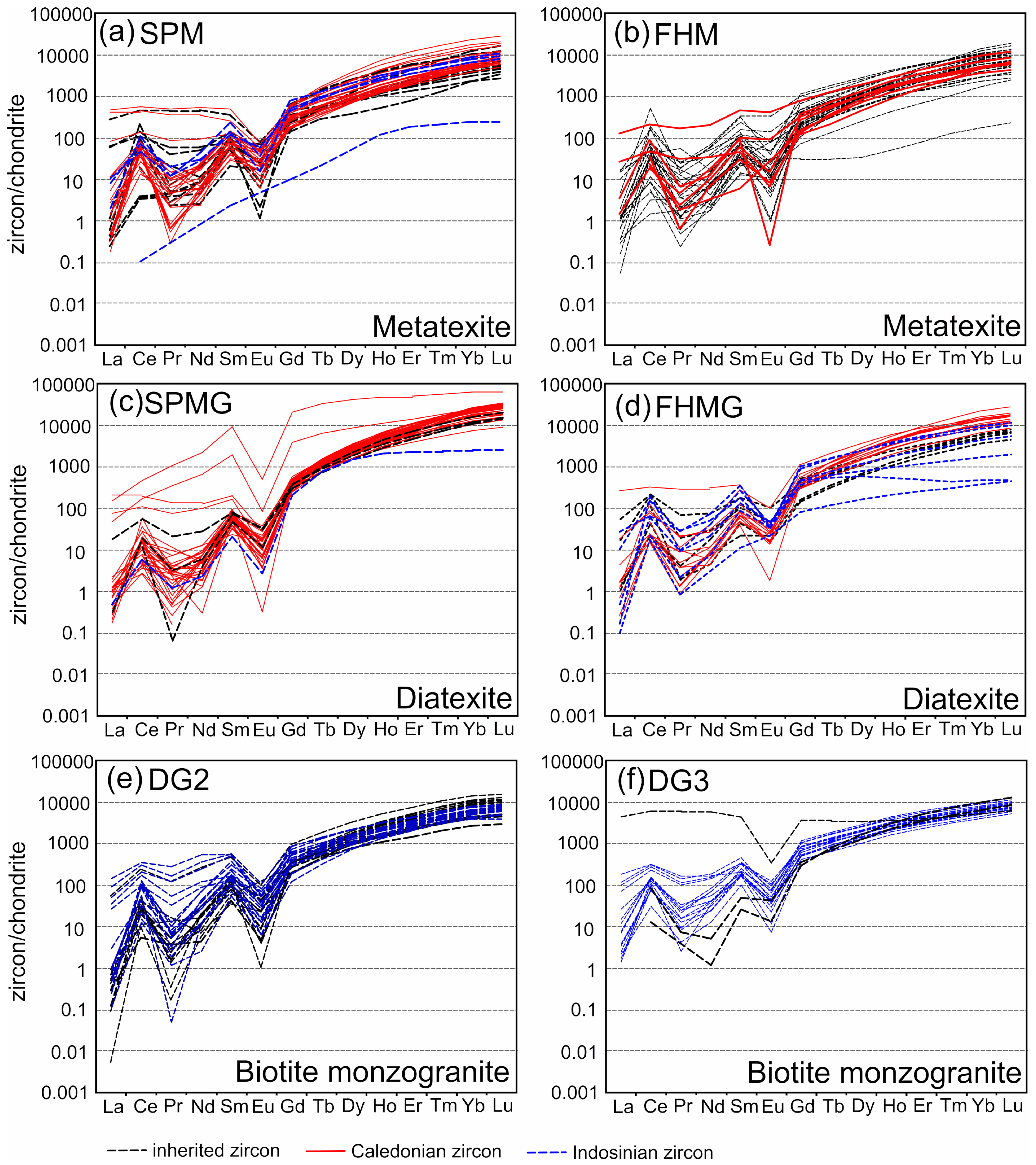
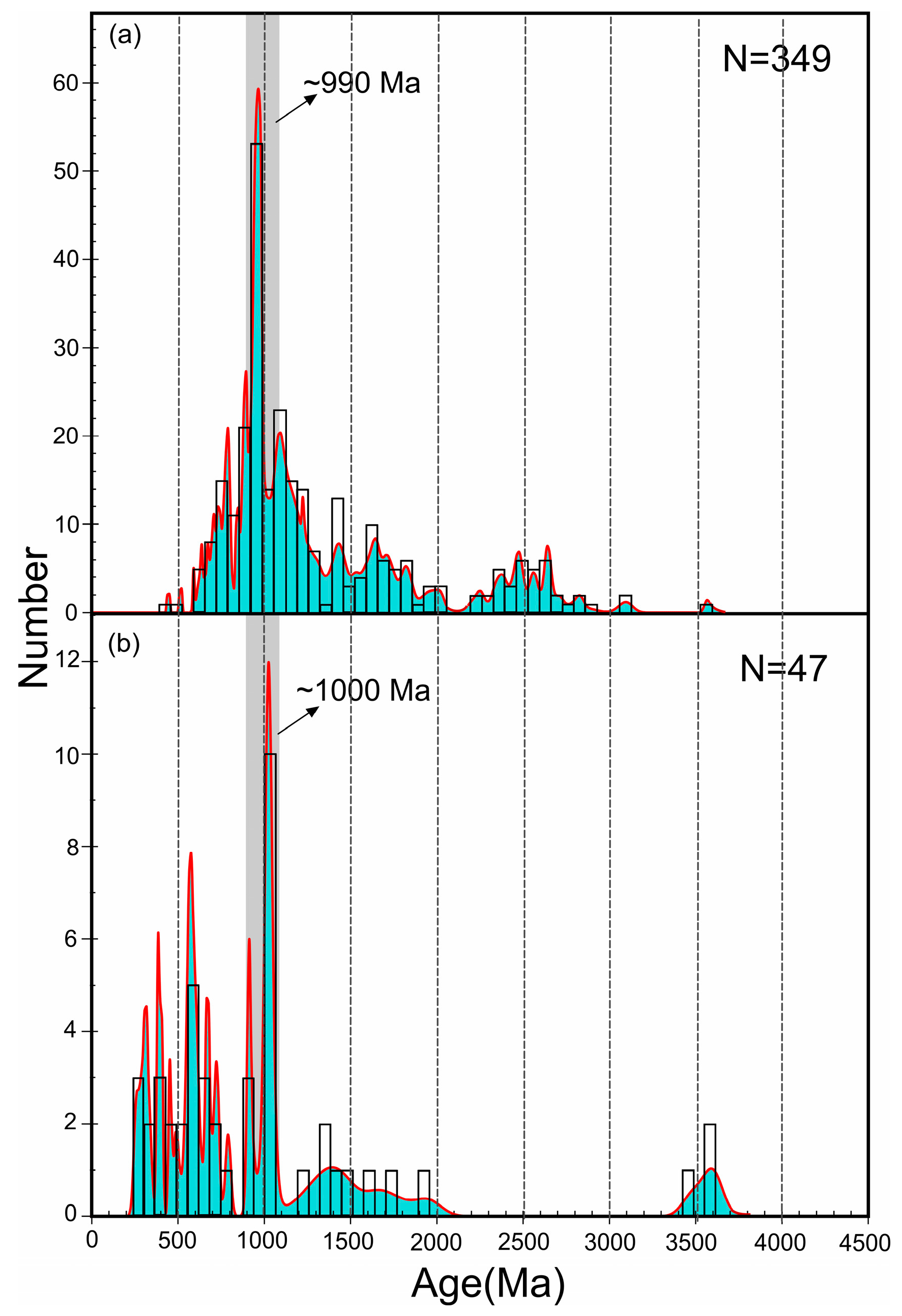
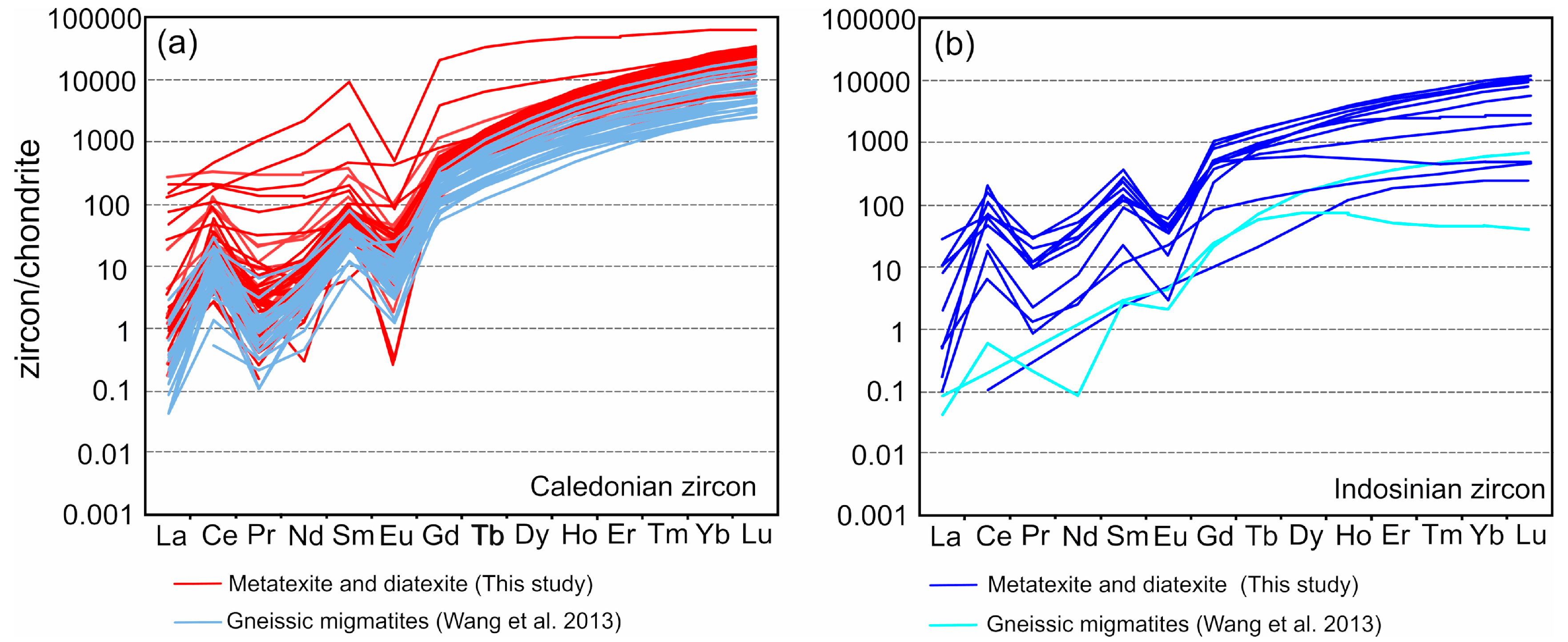
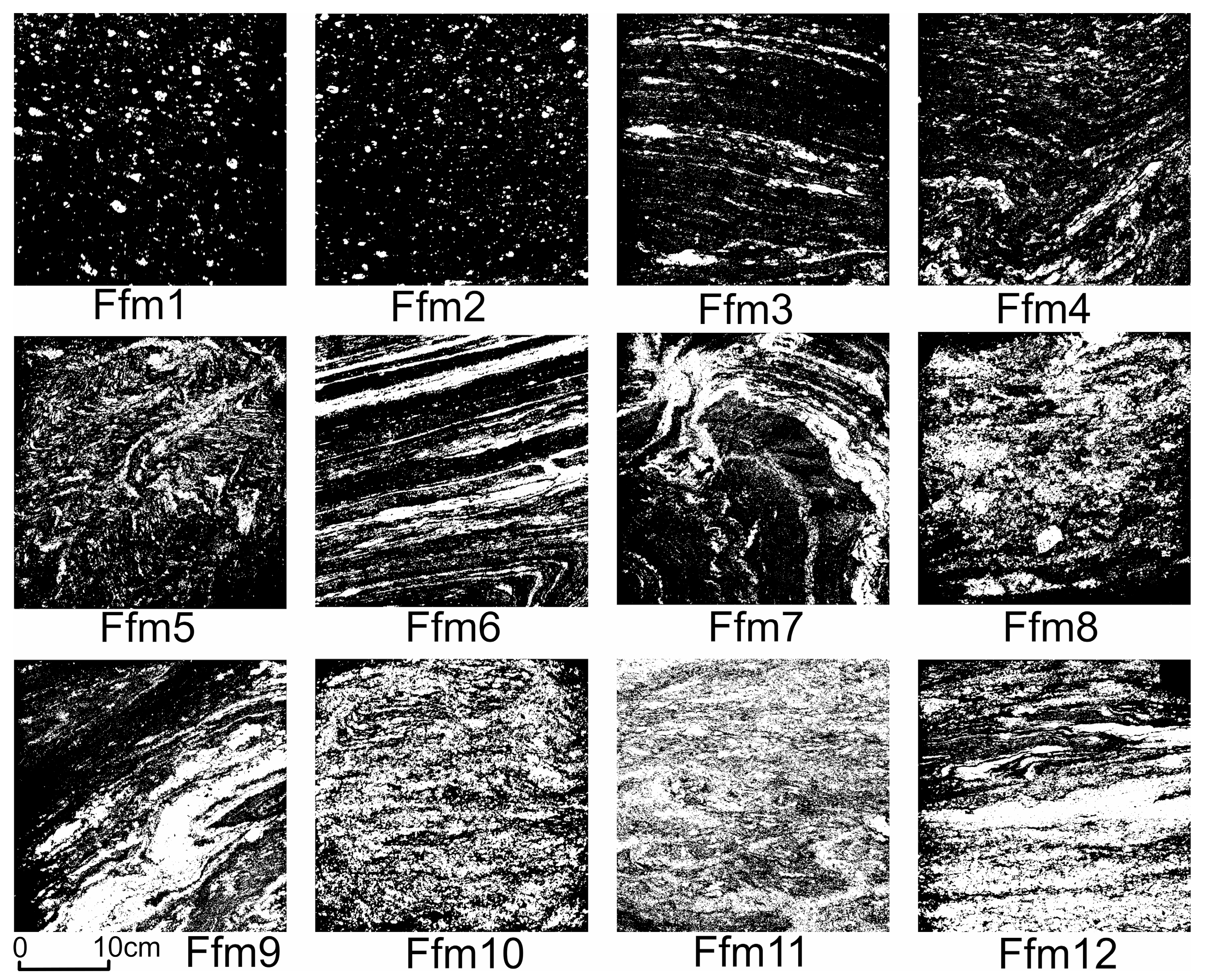

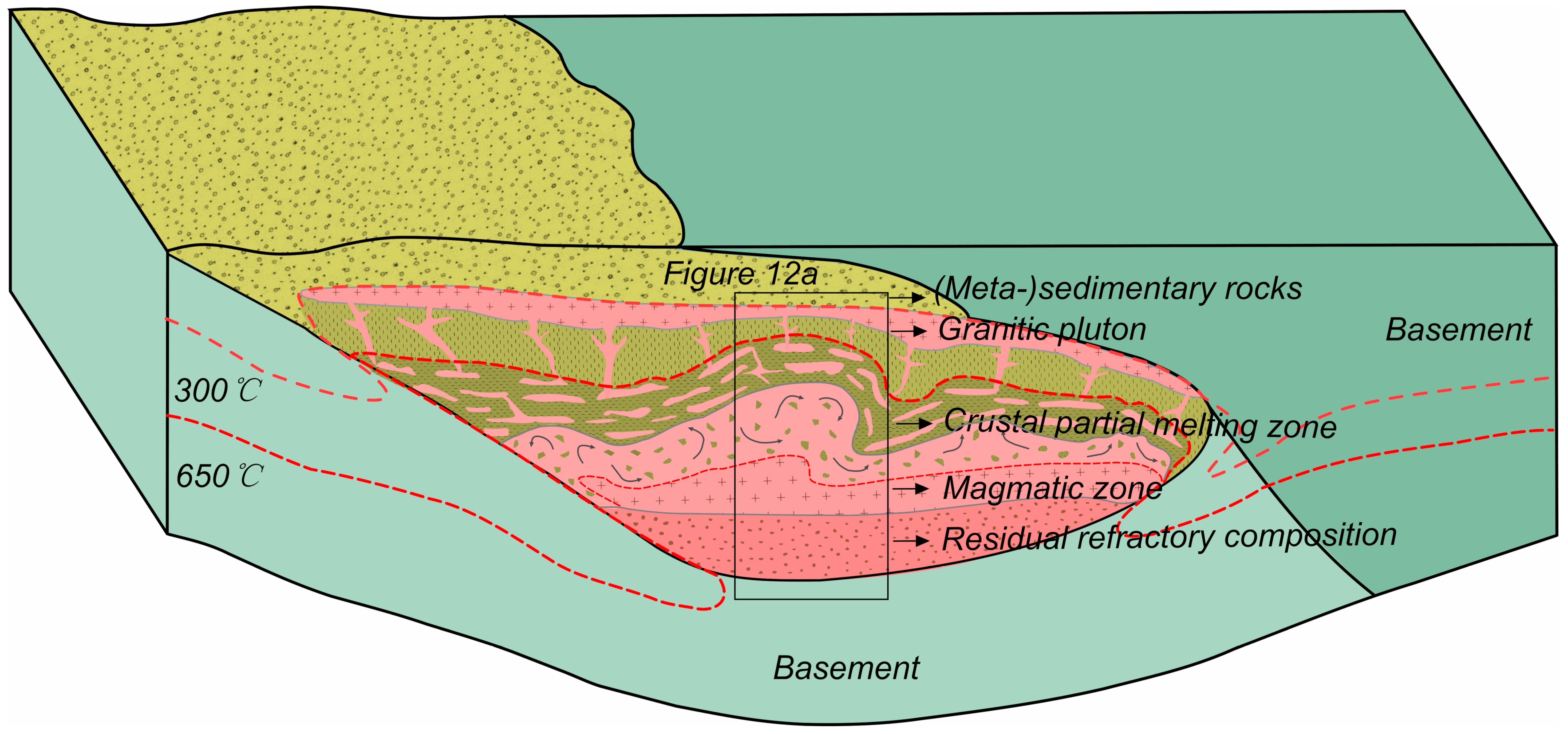
© 2019 by the authors. Licensee MDPI, Basel, Switzerland. This article is an open access article distributed under the terms and conditions of the Creative Commons Attribution (CC BY) license (http://creativecommons.org/licenses/by/4.0/).
Share and Cite
Zhang, J.; Liu, W.; Yakymchuk, C.; Sa, R.; Zeng, Z.; Ding, R.; Tang, G.; Liu, H.; Xu, Q.; Wang, Y. Partial Melting and Crustal Deformation during the Early Paleozoic Wuyi–Yunkai Orogeny: Insights from Zircon U-Pb Geochronology and Structural Analysis of the Fuhuling Migmatites in the Yunkai Region, South China. Minerals 2019, 9, 621. https://doi.org/10.3390/min9100621
Zhang J, Liu W, Yakymchuk C, Sa R, Zeng Z, Ding R, Tang G, Liu H, Xu Q, Wang Y. Partial Melting and Crustal Deformation during the Early Paleozoic Wuyi–Yunkai Orogeny: Insights from Zircon U-Pb Geochronology and Structural Analysis of the Fuhuling Migmatites in the Yunkai Region, South China. Minerals. 2019; 9(10):621. https://doi.org/10.3390/min9100621
Chicago/Turabian StyleZhang, Junhao, Weiliang Liu, Chris Yakymchuk, Rina Sa, Zhen Zeng, Ruxin Ding, Gongjian Tang, Hanqi Liu, Qingyan Xu, and Yong Wang. 2019. "Partial Melting and Crustal Deformation during the Early Paleozoic Wuyi–Yunkai Orogeny: Insights from Zircon U-Pb Geochronology and Structural Analysis of the Fuhuling Migmatites in the Yunkai Region, South China" Minerals 9, no. 10: 621. https://doi.org/10.3390/min9100621
APA StyleZhang, J., Liu, W., Yakymchuk, C., Sa, R., Zeng, Z., Ding, R., Tang, G., Liu, H., Xu, Q., & Wang, Y. (2019). Partial Melting and Crustal Deformation during the Early Paleozoic Wuyi–Yunkai Orogeny: Insights from Zircon U-Pb Geochronology and Structural Analysis of the Fuhuling Migmatites in the Yunkai Region, South China. Minerals, 9(10), 621. https://doi.org/10.3390/min9100621





